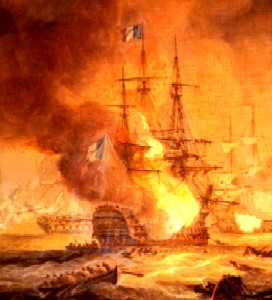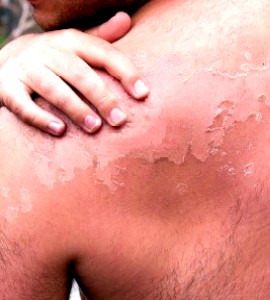
Treating Burns Page Selection Menu: 1 2 3 4 5 6 7 8 9 10 Next>>
Treating Burns During the Golden Age of Piracy, Page 1
"While the Swallow was sending their Boat to fetch the [Pirate] Prisoners, a Blast and Smoak was seen to pour Out of the great Cabin [of Captain Bartholomew Robert's captured ship], and they thought they were blowing up, but upon enquiry afterwards, found that half a dozen of the most Desperate, when they saw all Hopes fled, had drawn themselves round what Powder they had left in the Steerage, and fired a Pistol into it, but it was too small a Quantity to effect any Thing more, than burning them in a frightful Manner." (Captain Charles Johnson, The General History of the Pyrates, 3rd Edition, p. 268)
This was the last act of a group of especially desperate men, knowing the judgment was nigh. For whatever reason - be it fear of the noose, or not wanting to be ignominiously captured - they felt they would

Artist: Thomas Luny
Ship Alight at the Battle of the Nile (1834)
rather be burned to death than face judgment. Unfortunately, their plan miscarried and they were eventually led to trial in what may be the most thorough accounting of a golden age of piracy trial in popular literature as featured in Johnson's first book.1
The environment of the sailing ship is often referred to as "the wooden world" because it was a society unto itself, filled with all the intrigues of life on land, kept from sinking by a wall of wood and floors caulked with hemp rope saturated with pitch and kept moving by multiple sheets of billowing canvas sail often held in place by tar-coated ropes. Therein lay the problem - nearly everything inside the microcosm that was a ship at sea was highly flammable. As we'll see, rules and practises were implemented by sailors - even piratical ones - to keep the careless sailor from accidentally setting their flammable setting alight and endangering everyone.
Yet, in battle, the sailor's offense depended on flint and spark-lit guns and slow match fired cannon and deck guns. Gun crews in a hurry to fire and reload their charges would often slop powder around, creating the potential for inadvertent sparks to set men and ship alight. The enemy, knowing their opponent's weakness also tried to take advantage of the opposing ship's vulnerability by tossing grenades and other incendiaries onto the deck and into the sails , hoping to send all hands scurrying to douse the dangerous fires while they could still be controlled and abandoning their weapons in the process.
Thus, burns were an ever-present danger shipboard. Let's begin with how sailors came to be burned and then discuss the methods that period ship's surgeons used to deal with them. Then we'll examine how the ship surgeons attempted to heal such wounds.
1 For a complete account of the trial, see Captain Charles Johnson, The General History of the Pyrates, 3rd Edition, p. 281-329
Sunburn

The first source of burns is probably not what one typically brings to mind when considering burns on a ship, but since sailors worked outdoors most of the day, with the water reflecting the sun back at them, sunburns were an
ever present danger. Merchant captain Nathaniel Uring gives what is perhaps the most vivid period account of sunburn. "The Weather begin extream hot, and having no Wind and only my Shirt on, and that leaving my Thighs very often bare, the Heat of the Sun scorching them made me frequently throw Water on them to keep 'em cool, not thinking of the Consequence;
but soon after we landed I found them extreamly sore, very red, and blister'd in several Places, which grew very painful."1
This is the only direct period sailor's reference to sun bite which I have found. It can readily be supposed that men who worked on ships quickly acclimated to the sun just as people do today. Unless a sunburn case were particularly problematic, such as what Uring described above, it was probably just a part of the toughening process and so was ignored by most sailors.

Galen, from De Morbo Attonito Liber Unus,
by Justus Cortnumm, Title Page (1677)
In fact, there is even evidence that sunbathing was considered a bit of a recreational activity. In the the entry 5 July, 1689 of his journal, Jeremy Roch explains, "Now having nothing else to do, we put our fishing craft awork and caught some fish, which was a little diversion as well as a refreshing to us, while we lay here [in St. Helen's road] acoveing and sun burning."2
However, not everyone embraced sun burn quite so willingly and took some precautions against it. Edward Coxere mentions crabs being taken in Newfoundland that were "as broad as sun-hats"3, suggesting the availability and use of sun protectors at this time, even if not directly referencing their use at sea.
Although none of the period sea-surgeons take up the topic of sunburns, a cure is suggested by one of the revered ancients of surgery, Galen, for those "repeatedly seized with sunanche": blood-letting.4 He doesn't give specifics on why this would work, although perhaps he felt it had something to do with the color of the skin.
1 Nathaniel Uring, A history of the voyages and travels of Capt. Nathaniel Uring, p. 137-8; 2 Jeremy Roch, from Bruce S.Ingram, Three Sea Journals of Stuart Times, 1936, p. 115; 3 Edward Coxere, Adventures by Sea of Edward Coxere, p. 121; 4 Peter Brain, Galen on Bloodletting, p. 82
;

